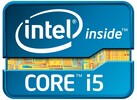Intel Core i5-2410M vs AMD A6-7000 vs Intel Core i5-2537M
Intel Core i5-2410M
► remove from comparison
The Intel Core i5-2410M is a fast dual core processor at the time of introduction in Q1 2011. It is based on the Sandy Bridge architecture and offers Hyperthreading to handle 4 threads at once (for a better usage of the pipeline). Compared to the faster Core i7, the i5 offers a smaller last level cache of 3MB. The base clock speed is 2.3 GHz but due to Turbo Boost it can reach 2.6 GHz (2 cores active) and 2.9 GHz (1 core active). Compared to the 2510M, the 2410M does not support AES, VT-d, and Trusted Execution functions.
Sandy Bridge is the evolutionary successor of the Arrandale architecture. The most noteable improvements is the improved Turbo 2.0 and the integration of the graphics card into the 32nm CPU core.
The i5-2410M offers an integrated graphics card (Intel HD Graphics 3000) which is clearly faster then the older Intel HD Graphics in the Arrandale CPUs. As the new GPU is included in the CPU, it is also manufactured in 32nm and shares the fast level 3 cache with the CPU cores (using a new ring bus). In the 2410M it is clocked from 650-1200MHz (with Turbo Boost). The faster Sandy Bridge CPUs are clocked up to 1300 MHz (like the i5-2520M).
Furthermore, an improved dual-channel DDR3 memory controller is included on the CPU die that is used by the CPU and GPU part.
Due to the improved architecture and the new Turbo Boost 2.0, the average performance of the Core i5-2410M is higher than a similar clocked Arrandale Core i5. In our benchmarks, the 2410M was able to beat the fast Intel Core i5-560M with 2.7-3.2GHz and is therefore suited for even demanding tasks.
The 35W TDP rating includes the integrated GPU and memory controller.
AMD A6-7000
► remove from comparisonDer AMD A6-7000 ist ein mobiler Dual-Core-Prozessor, der auf der Kaveri-Architektur basiert. Zusätzlich zu einem einzelnen CPU-Modul (2 Integer-Kerne) integriert der Chip auch eine Radeon-R4-Grafikeinheit mit 192 GCN-Shadern. Die Taktraten liegen bei 2,2 bis 3,0 GHz für den Prozessor-Part und 533 MHz für die GPU. Entsprechend seiner TDP von 17 Watt ist der Chip für schlanke Notebooks ab etwa 11 - 12 Zoll geeignet.
Intel Core i5-2537M
► remove from comparison
Der Intel Core i5-2537M ist ein stromsparender ULV (Ultra Low Voltage) Prozessor für Subnotebooks. Mit 1.4 GHz Basistaktfrequenz ist er relativ gering getaktet, jedoch kann er dank Turbo Boost bis zu 2.3 GHz hochtakten (2 Ghz bei Belastung beider Kerne). Durch die Unterstützung von Hyperthreading können 4 Threads gleichzeitig bearbeitet werden.
Sandy Bridge ist eine Weiterentwicklung der Arrandale Architektur. Neben Optimierungen sind besonders die neuen 256 Bit AVX Instruktionen im CPU Teil und der verbesserte Turbo 2.0 erwähnenswert. Weiters sind nun ebenfalls AES Funktionen und ein verbesserter Dual Channel DDR3 Speicherkontroller für max. 8 GB DDR3-1333MHz direkt im Prozessor integriert.
Die intergrierte DirectX 10 fähige Intel HD Graphics 3000 Grafikkarte ist direkt in der CPU untergebracht und teilt sich mit dieser den Level 3 / Last Level Cache. Dadurch sinkt zwar die Prozessorleistung etwas bei aktivierter Grafik, die Grafikleistung ist jedoch deutlich besser als bei der alten Intel HD Graphics in ULV Notebooks. Vergleichen mit den stärkeren 35 Watt Doppelkernprozessoren ist die Grafikleistung jedoch aufgrund der geringeren Taktfrequenz deutlich schlechter (350 versus 650 MHz Basistakt, 900 versus 1100-1300 MHz Turbo Boost).
Die Performance liegt dank der verbesserten Architektur und des überarbeiteten Turbo Boost etwas oberhalb einer ähnlich getakteten Arrandale CPU. Dadurch sollte die Leistung auf dem Niveau des Core i7-680UM liegen und damit in der Nähe des Core i3-330M (falls der Turbo Boost dank ausreichend Kühlung gut funktioniert).
Die Sandy Bridge Doppelkernprozessoren beinhalten im angegebenen TDP von 17 Watt auch die Grafikkarte und den Speicherkontroller. Durch den Turbo Boost 2.0 wird der TDP jedoch unter Last eher ausgenutzt. Mit 17W TDP eignet sich der Prozessor auch für kleine und leichte Notebooks.
| Model | Intel Core i5-2410M | AMD A6-7000 | Intel Core i5-2537M | ||||||||||||||||||||||||||||||||||||||||||||||||||||||||||||||||||||||||||||||||||||||||||||||||||||||||||||||||||||||||
| Codename | Sandy Bridge | Kaveri | Sandy Bridge | ||||||||||||||||||||||||||||||||||||||||||||||||||||||||||||||||||||||||||||||||||||||||||||||||||||||||||||||||||||||||
| Series | Intel Core i5 | AMD Kaveri | Intel Core i5 | ||||||||||||||||||||||||||||||||||||||||||||||||||||||||||||||||||||||||||||||||||||||||||||||||||||||||||||||||||||||||
| Serie: Core i5 Sandy Bridge |
|
|
| ||||||||||||||||||||||||||||||||||||||||||||||||||||||||||||||||||||||||||||||||||||||||||||||||||||||||||||||||||||||||
| Clock | 2300 - 2900 MHz | 2200 - 3000 MHz | 1400 - 2300 MHz | ||||||||||||||||||||||||||||||||||||||||||||||||||||||||||||||||||||||||||||||||||||||||||||||||||||||||||||||||||||||||
| L1 Cache | 128 KB | 128 KB | |||||||||||||||||||||||||||||||||||||||||||||||||||||||||||||||||||||||||||||||||||||||||||||||||||||||||||||||||||||||||
| L2 Cache | 512 KB | 1 MB | 512 KB | ||||||||||||||||||||||||||||||||||||||||||||||||||||||||||||||||||||||||||||||||||||||||||||||||||||||||||||||||||||||||
| L3 Cache | 3 MB | 3 MB | |||||||||||||||||||||||||||||||||||||||||||||||||||||||||||||||||||||||||||||||||||||||||||||||||||||||||||||||||||||||||
| Cores / Threads | 2 / 4 | 2 / 2 | 2 / 4 | ||||||||||||||||||||||||||||||||||||||||||||||||||||||||||||||||||||||||||||||||||||||||||||||||||||||||||||||||||||||||
| TDP | 35 Watt | 17 Watt | 17 Watt | ||||||||||||||||||||||||||||||||||||||||||||||||||||||||||||||||||||||||||||||||||||||||||||||||||||||||||||||||||||||||
| Transistors | 624 Million | 624 Million | |||||||||||||||||||||||||||||||||||||||||||||||||||||||||||||||||||||||||||||||||||||||||||||||||||||||||||||||||||||||||
| Technology | 32 nm | 28 nm | 32 nm | ||||||||||||||||||||||||||||||||||||||||||||||||||||||||||||||||||||||||||||||||||||||||||||||||||||||||||||||||||||||||
| Die Size | 149 mm2 | 149 mm2 | |||||||||||||||||||||||||||||||||||||||||||||||||||||||||||||||||||||||||||||||||||||||||||||||||||||||||||||||||||||||||
| max. Temp. | 100 °C | 100 °C | |||||||||||||||||||||||||||||||||||||||||||||||||||||||||||||||||||||||||||||||||||||||||||||||||||||||||||||||||||||||||
| Socket | rPGA988B / BGA1023 | BGA1023 | |||||||||||||||||||||||||||||||||||||||||||||||||||||||||||||||||||||||||||||||||||||||||||||||||||||||||||||||||||||||||
| Features | HD Graphics 3000 (650-1200MHz), DDR3-1066/1333 Memory Controller (max 16GB), HyperThreading, AVX, Quick Sync, Virtualization | SSE (1, 2, 3, 3S, 4.1, 4.2, 4A), x86-64, AES, AVX, FMA, DDR3-1600 Controller | HD Graphics 3000 (350-900MHz), DDR3-1066/1333 Memory Controller (max 8GB), HyperThreading, AVX, Quick Sync, Virtualization | ||||||||||||||||||||||||||||||||||||||||||||||||||||||||||||||||||||||||||||||||||||||||||||||||||||||||||||||||||||||||
| iGPU | Intel HD Graphics 3000 (650 - 1200 MHz) | AMD Radeon R4 (Kaveri) (? - 533 MHz) | Intel HD Graphics 3000 (350 - 900 MHz) | ||||||||||||||||||||||||||||||||||||||||||||||||||||||||||||||||||||||||||||||||||||||||||||||||||||||||||||||||||||||||
| Architecture | x86 | x86 | x86 | ||||||||||||||||||||||||||||||||||||||||||||||||||||||||||||||||||||||||||||||||||||||||||||||||||||||||||||||||||||||||
| Announced | |||||||||||||||||||||||||||||||||||||||||||||||||||||||||||||||||||||||||||||||||||||||||||||||||||||||||||||||||||||||||||
| Manufacturer | ark.intel.com | www.amd.com | ark.intel.com | ||||||||||||||||||||||||||||||||||||||||||||||||||||||||||||||||||||||||||||||||||||||||||||||||||||||||||||||||||||||||
| $250 U.S. |
Benchmarks
Average Benchmarks Intel Core i5-2410M → 0% n=0
Average Benchmarks Intel Core i5-2537M → 0% n=0
* Smaller numbers mean a higher performance
1 This benchmark is not used for the average calculation











